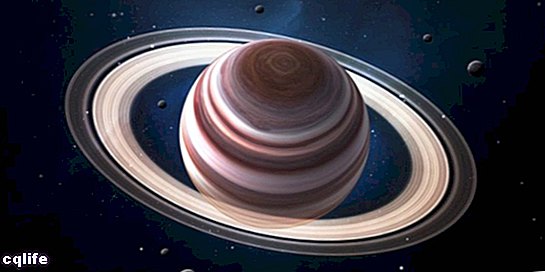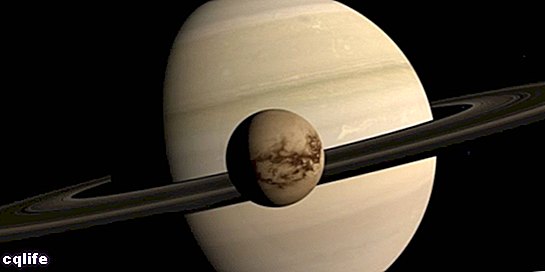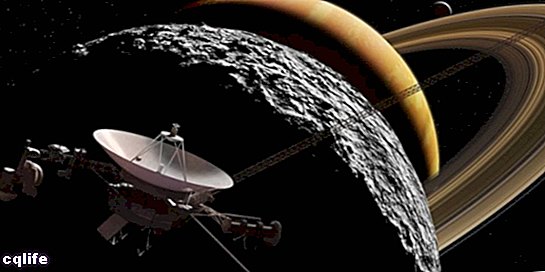- What is Saturn?
- Saturn Characteristics
- Moons of saturn
- Saturn's rings
- Space exploration to Saturn
- Comparison between Saturn and Earth
We explain everything about the planet Saturn, its moons, rings and other characteristics. Also, his space exploration.

What is Saturn?
Saturn is the second planet largest of the Solar system and is the sixth in order of distance from Sun, located 1,400 million kilometers from the luminous star. Its composition is gaseous and it is the first planet where rings, composed of ice, rock and dust (the rings of Jupiter Y Neptune were identified more recently).
The origin of Saturn is uncertain, however, scientists support the theory that it formed with the beginning of the Solar System (about 4.5 billion years ago), when a force of gravity That attracted eddies of gas and dust, generated a gigantic gaseous mass. For about 4,000 million years the planet has been in its current position, that is, in sixth place with respect to the Sun.
Its name arose in the time of the Greeks and Romans, who inherited from the Sumerians the knowledge about astronomy and above the sky. Saturn was the Roman god of farming, father of Jupiter. Since Saturn was further from the Sun compared to Jupiter, ancient astronomers identified it as the "father."
Saturn Characteristics
Saturn is made up of gases (mostly hydrogen and helium), its volume is 755 times greater than that of the Earth and have one density 0.687 grams per cubic centimeter (a density less than that of water). In the hypothetical case that the planet landed on an immense ocean of Water, it would not sink, but would float.
The planet does not have a solid surface, except for some frozen clouds of ammonia or ammonia hydrosulfide, which are scattered on the gaseous surface.
Deep down, near its core, hydrogen is compressed to the point where it becomes liquid. Its core seems to be heavier and rockier, made up of metallic elements like iron and silicates.
The winds that are generated in the atmosphere can reach 1,800 kilometers per hour that, when merging with the heat emerging from inside the planet, create yellow and gold bands that are visible from Earth (when viewed through a telescope). The temperature average on its surface is -130º centigrade.
Saturn takes 11 Earth hours to rotate on its own axis (the movement rotation) and 29 years, approximately, in making a orbit complete around the Sun (the translational motion). Its axis has an inclination of 26.73 degrees with respect to its solar orbit (similar to the inclination of the Earth's axis, of 23.5 degrees).
Moons of saturn

Saturn has 53 natural satellites and at least 29 moons that continue to be studied to verify that they are satellites (that is, it has not yet been corroborated if they remain in constant orbit around the planet).
Saturn's satellites are very varied, some are made up of gases and covered in haze (like Titan), others are made up of solid surfaces filled with craters (like Phoebe). Prometheus and Pandora are two of the smallest satellites that orbit close to the ring system and help shape the structure of the halos due to their own gravitational force.
The largest of the satellites is Titan and is characterized by having an atmosphere (rich in methane), something unusual for a moon. The rest of the satellites that belong to the group of the largest are: Mimas, Enceladus, Tethys, Dione, Rea, Hyperion, Iapetus and Phoebe.
Scientists are especially investigating Titan (for being the largest moon and for its notorious atmosphere), Enceladus (because there is the possibility of containing liquid water at a shallow depth) and the moons Hyperion and Iapetus (which are characterized by containing , almost entirely, ice water).
Saturn's rings
Saturn's ring system is largely made up of icy water and rockfalls of various sizes. They are distributed into two groups that are separated by the "Cassini division": the A (outer) rings and the B (inner) rings according to their proximity to the planet's surface.
The name of the division arose from its discoverer, Giovanni Cassini, a naturalized French Italian astronomer who, in 1675, detected that separation of 4,800 kilometers wide. Group B is made up of hundreds of rings, some elliptical that show variations in undulating density due to the gravitational interaction between the rings and the satellites.
In addition, there are dark structures called "radial wedges" that rotate around the planet at a rhythm different than the rest of the material of the rings (its movement is governed by the magnetic field of the planet).
The origin of the radial wedges is still unknown and it is possible that they appear and disappear in a stationary manner. According data Obtained in 2005 from the Cassini spacecraft expedition, there is an atmosphere around the rings, composed mainly of molecular oxygen.
Until 2015, theories about how Saturn's rings were generated could not explain the existence of the small ice particles. Scientist Robin Canup published her theory that, during the birth of the Solar System, a satellite of Saturn (made up of ice and a rocky core) sank into the planet causing a collision.
As a consequence, the huge fragments were ejected to form a kind of halo or ring of various particles that continued to hit each other as they lined up in the planetary orbit until they gave rise to the great ring that is known today.
Space exploration to Saturn

There is evidence that, in 700 BC, the Assyrians described the ringed planet as a flash in the night and called it the "star of Ninib." Around 400 B.C. ancient Greek astronomers named Kronos which they consider a star wandering and then, the Romans, changed his name to Saturn, father of Jupiter.
In 1610 Galileo Galilei observed through a telescope and was able to identify two objects that accompanied the planet and called it a “triple planet”. Galileo could not recognize the shape of these two objects, but he could see that they remained in position relative to the celestial body.
The great unknown that haunted scientists at the time was how these objects could remain around Saturn without breaking or colliding with the planet.
In 1659 the astronomer Christiaan Huygens managed to identify with a powerful telescope that the two objects that surrounded Saturn were flattened rings. In 1857 the scientist James Clerk Marxwell predicted, using mathematical formulas, that the composition of the rings consisted of numerous small particles.
In 1979 the "Voyager" probe sent by NASA was the first to reach Saturn and managed to collect information enough to corroborate Marxwell's theory.
In 1997 the Cassini-Huygens probe was launched with the objective to fly well close to Saturn. Years later, this expedition obtained valuable information: images, data on waves, cloud movements and details of the rings, among others.
In 2005, the Huygens probe sent by the European Space Agency (ESA) was the first spacecraft to make a landing on the surface of the moon Titan. He managed to carry out the first study of the atmosphere and the relief of the natural satellite through direct images.
In 2017, the Cassini spacecraft ended its mission after 13 years of activity, sending data until its last moment. Cassini's last five orbits provided direct and key information about Saturn's atmosphere.
Comparison between Saturn and Earth

